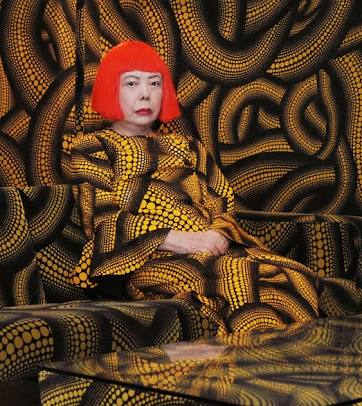
Shortly after 3 o’clock on Thursday afternoon, the Art Gallery of Ontario had sold out a third block of 15,000 tickets for what could be the gallery’s most popular exhibit ever.
In New York, crowds lined up for up to six hours in the bitter cold to see a couple of Yayoi Kusama’s works.
Toronto is only the fourth city in North America where people can see the full exhibit of Infinity Mirrors — a collection of mirrored rooms creating the illusion of infinite space filled with different visual elements, from polka dots and pumpkins to lights.
Visitors have a time limit of only 20 or 30 seconds in each room, and it’s an experience that lends itself to multiple selfies shared on social media.
“We’re ecstatic,” said Herman Lo, the AGO’s director of community outreach, about online ticket sales this week. Lo says would-be visitors are logging on not just from Canada but from around the world to see the exhibit, which opens March 3.
The 88-year-old Japanese artist’s show attracted huge crowds for the three previous stops of its North America tour: Washington, Seattle and L.A.
Jaclyn Tersigni’s post on @agotoronto Tuesday is just one example of the ticket-buying frenzy.
Tersigni showed her place in line on the second day of ticket sales — 8,887th.
Across the screen grab, a banner reads “Yayoi. Day Two.” Thursday was worse – 23,752nd. But she got lucky — a friend offered to sell her two tickets at the regular price, $30 each.
Tersigni says she became a fan of Yayoi Kusama while in university, “reading about this bad-ass female artist” who protested the Vietnam War in 1968 by writing an open letter to Richard Nixon, offering to sleep with him if he would stop the war.
Stories like Tersigni’s shared on social media have become part of the Kusama phenomenon, says Leah Sandals, the online editor of the magazine Canadian Art.
For her part, Sandals says she is experiencing “social media exhaustion” after being inundated by Instagrammed selfies from Kusama’s six mirrored rooms.
She says the 20- or 30-second limit — specified by the artist — is part of the draw of the show.
“I would say that’s a huge part of what’s driving it,” said Sandals, “and then the stories that people share on social media about waiting for so long in line and then it being so worthwhile to wait.”
Three people are allowed in each mirrored room at a time, creating what Sandals calls a “compressed, intimate experience,” unlike the distracted environment in which many people live today.
If 20 seconds doesn’t seem like a lot of time to spend with a work of art, Sandals points out that studies have shown a lot of people don’t spend more than four or five seconds in front of an artwork in a gallery.
“What that time limit does,” said Sandals, “is focus people’s attention in a strong way.”
Artist paints her own hallucinations
Sandals says she also finds the artist’s back story intriguing.
Discouraged by her parents from making art, Kusama made her way to New York in the 1960s, meeting Andy Warhol, Georgia O’Keefe and other celebrity artists of that era. She returned to Japan, said Sandals, “dejected and poor,” checking herself into a psychiatric facility where she lives to this day.
In interviews, Kusama has said her art depicts hallucinations she began experiencing as a child.
Speaking to the Guardian last fall at the opening of a new museum in Tokyo dedicated to her work, Kusama said, “I still see hallucinations even now. Dots come flying everywhere — on my dress, the floor, things I’m carrying, throughout the house, the ceiling. And I paint them.”
Art gallery administrators are able to capitalize on those painted hallucinations to drive individual ticket sales and memberships. It also helps burnish the international reputation of galleries to land high-profile exhibits of this kind, says Sandals.
Of the AGO’s profile, Sandals said, “I’m sure they’re hoping to see a huge bump internationally.”
But Sandals is less impressed by the AGO’s failure to connect the dots in Kusama’s show to home-grown artists, a recurring criticism of the AGO’s focus on international blockbusters.
“Whenever you give space to a big name, it means that space is not going to artists who are less well-known,” Sandals said.
She says the AGO could have leveraged Kusama’s Infinity Mirrors to introduce the flood of gallery newcomers to other artists who might interest them, “if they were given a chance to exit the Kusama exhibition and then enter an exhibit of other women artists over the age of 80, like Rita Letendre and Katie Ohe (both Canadian sculptors).”
The AGO’s former Canadian art curator, Andrew Hunter, says the AGO’s blockbuster shows also get the lion’s share of marketing and media publicity.
Hunter says a show he curated at the AGO to mark Canada’s 150th anniversary, called Every Now Then, closed early to make way for the Kusama exhibit.
“What makes Ontario and Canada creative and powerful and messy,” said Hunter, “gets lost when you’re competing on being world-class.”
But the AGO’s Lo sees it differently. The Kusama show is a “gateway,” he says.
“This is getting new visitors through the doors, showcasing the AGO. Once they’re in for Kusama, how do we pique their interest in other exhibits and Canadian artists?”
By CBC
Looking for unique art? Click here








